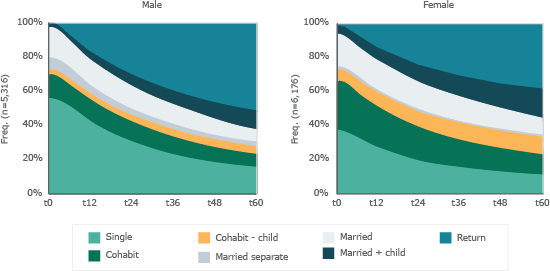Polish migration within Europe has increased sharply since Poland’s entry to the European Union in 2004. Over the past decade, Poles are the largest group of foreign nationals settling in the Netherlands. Still, little is still known about the link between migration and family behaviours of this group of immigrants. Tom Kleinepier, Helga A. G. de Valk, and Ruben van Gaalen address this gap in their latest study and find six different types of family life paths among young adult Polish migrants. They also identify important gender differences in family and migration behaviour. Polish women tend to migrate with their partners, while men predominantly migrate alone and are more likely to return to the country of origin.
Female and male migrants differ in their life paths
Kleinepier et al. also found significant differences when analyzing family states and return migration between young Polish men and women living in the Netherlands (Figure 1). More than half of Polish men were single when they moved to the country and about one quarter of those who were married arrived without their partner. Women, instead, show a lower proportion of singles (40%) and a larger share of married women who migrated with their partners. The largest difference regards migrants living in cohabitation: the proportion is almost twice as large for women as for men.
One feature shared by most part of Polish men and women is that they did not have children upon their arrival in the Netherlands. However, this situation reverses with time: after 5 years of residence in the country, almost 60% of married Poles become parents.
The authors also found that a large share of Polish migrants live only temporarily in the Netherlands, but men are more likely to return (50%) compared to women (35%).
Family and migration patterns: a complex story
Kleinepier and colleagues identify six family trajectories of Polish migrants coexisting in the Netherlands . The most prevalent, accounting for 32.9% of migrants, is the “return trajectory” in which the majority of Polish migrants did not live with a partner during their time of residence in the Netherlands and left the country without returning.
The second, following its prevalence pattern (19,1%), is the “solo trajectory” in which most part of Poles live without a partner during the 5 year-period of observation. Some of them tend to move back and forth between Poland and the Netherlands, often referred to as ‘circular migration’.
The third is the “cohabiting trajectory” (14.8%). Within this group, migrants are single upon their arrival in the Netherlands and start cohabiting after several months. After five years, some of them get married and/or have children. The fourth trajectory type - “non-marital birth trajectory” (7.1%) - also includes a long period of non-marital cohabitation but differs from the former because this is accompanied by a long period of non-marital parenthood.
The last two trajectory types - the “marriage trajectory” (14.7%) and the “marital birth trajectory” (11.4%) - are both marked by a long period of living with a married partner but there are some important differences between the two groups. In the first trajectory return migration is the mainstream after a long marriage period lived in the country, while in the second the migrants have children and stay in the Netherlands.
Kleinepier et al. found that return migration is uncommon in both the non-marital and the marital birth trajectories, and suggest that the presence of children in the household of Polish migrants decreases the propensity to leave the Netherlands.

Figure 1. Aggregated distribution (%) of family states and return migration of Polish migrants over a period of 60 months (5 years) measured since their arrival in the Netherlands (at t0 –month 0- ) until the 60th month (t60), by gender.
This Population Digest has been published with financial support from the Progress Programme of the European Union in the framework of the project “Supporting a Partnership for Enhancing Europe’s Capacity to Tackle Demographic and Societal Change”.